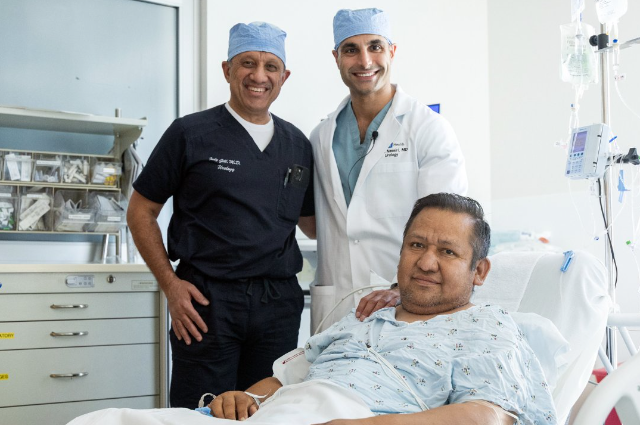A medical miracle happened on 4th May 2025 at the Ronald Reagan UCLA Medical Center, USA, where the world’s first human bladder transplant occurred. The recipient, 41–year–old Oscar Larrainzar’s kidneys and bladder had stopped working after being destroyed by cancer. After spending seven years on dialysis, he finally got another chance in life after getting a deceased donor’s kidneys and bladder.
The transplant, which was an eight-hour-long procedure, was led by Dr Inderbir Gill, MD, and founding executive director at USC Urology, and Dr Nima Nassiri, USC Health. This successful surgery has presented itself as a beacon of hope for millions of patients and doctors worldwide.
About The Recipient, Oscar Larrainzar
Oscar Larrainzar, a 41-year-old father of four from Southern California, had been battling a rare type of cancer, which affected most of his bladder. For seven years, Oscar had been dependent on dialysis to keep his body working, as both his kidneys had also been damaged.
“I was a ticking time bomb,” Oscar said, commenting on his deteriorating health. “There was no real solution. I had lost hope that anything could get better.” But it seemed that destiny had its own plans. It was in May 2025 when he was informed about a deceased donor whose kidneys and bladder could be transplanted.
“I didn’t know if it would work, but I knew I didn’t want to keep living the way I was,” said Oscar. After the completion of the eight-hour surgery, he no longer required dialysis and could urinate naturally. Oscar is grateful for his improvement, as after nearly a decade, he doesn’t have to rely on a catheter to urinate.
About the Procedure
The world’s first-ever bladder transplant took place at the Ronald Reagan UCLA Medical Center, USA. The surgeons, Dr Inderbir Gill and Dr Nima Nassiri, had to perform perfect vascular anastomoses by connecting the donor bladder’s blood vessels to the recipient, Oscar’s iliac vessels. As this was a first-time surgery, the doctors had to be careful with every step.
“The vascular and urologic demands of the surgery were unprecedented,” remarked Dr. Gill. Dr Gill’s companion, Dr Nassiri, gave us an insight into the complex surgery, “Unlike intestine–based reconstructions, this bladder transplant offered native compliance and detrusor function – a game changer for urinary rehabilitation.” Oscar’s body responded to the operation, which is a good sign for the doctors.
About the Doctors
This surgery wouldn’t have been possible without the skillful minds and continuous efforts of Dr Inderbir Gill and Dr Nima Nassiri, along with their wonderful team of doctors at UCLA.
Dr. Inderbir Gill is a Professor and Chair of Urology at the Keck School of Medicine of USC. He has published around 980 scientific papers and has also been conferred with the prestigious Dr. B.C. The Roy National Award for Eminent Medical Person was presented by the President of India in 2005. His associate, Dr. Nima Nassiri, Director of the Vascularized Composite Bladder Allograft Transplant Program at UCLA.
The eight-hour operation was a culmination of the doctors’ years of hard work and determination. They collaborated at the Keck School to develop the technology behind this operation, including conducting robotic trials and practice runs using donor organs.
Their happiness was evident when Oscar Larrainzar finally responded to the treatment. “He peed,” Dr. Nassiri said to Dr. Gill, and his instant reply was, “No way. What the hell!” The operation even required the assistance and coordination of various other doctors. Acknowledging the role of their dedicated team of doctors, Dr. Gill said, “It was like assembling a symphony. Every specialty had a part to play, and the harmony of this teamwork is what led to success.”
About the Medical Benefits
The success of this operation marks a stepping stone in the direction of reconstructive and transplant medicine. Bladder diseases often cause discomfort to patients, and doctors have limited options to ease their pain. Earlier treatments included creating a substitute bladder from intestinal tissue, but it came with the risks of infections and complications.
However, by using a vascularized bladder allograft, as used in this surgery, the possibility of risks has been reduced. Moreover, as the surgery didn’t complicate the situation, it is a major milestone in the field of urology. Dr. Nassiri is optimistic about the outcome: “This gives us proof of concept that a human bladder can be transplanted successfully and function as intended.”
This breakthrough in the field of science is no small feat, as it gives a chance to patients suffering from bladder dysfunction to recover and lead a healthy life. The impact of this newfound knowledge will benefit millions and will continue to do so with the introduction of more advanced research and technology.
For Oscar Larrainzer and his family, the donor was a blessing in disguise. This sets an example for the medical community as well as for civilians that the donation of any organs can be a lifesaving step for an individual. Together with the introduction of this groundbreaking procedure, a new chapter in medical science awaits us.
As Dr. Gill summarized it, “This is not the end – it’s the beginning of what we can do for patients with organ loss.”
The future of urology science looks bright and promising for not only the patients but also for the doctors.

